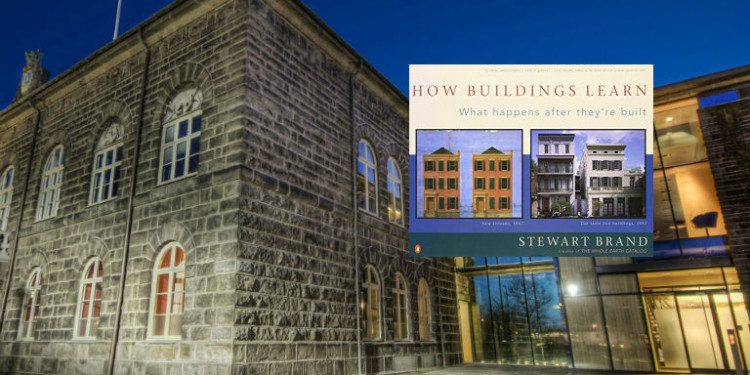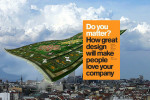How design changes over time

Buildings are not complete and perfect when they are constructed. They change over time, support multiple uses, and host unforeseen tenants.
How Buildings Learn: What Happens After They’re Built by Stewart Brand
Architecture as commonly practiced tends to overlook the dynamic nature of our structures and instead imagines a pure, never-changing aesthetic. How Buildings Learn is an exploration of how various types of buildings evolve and grow with and around their successive inhabitants. Buildings must be in harmony with our human need to adapt our environments to our changing needs. The book advocates “working with time, instead of against it.”
Author Stewart Brand illustrates that open structures which invite customization are the most amenable to future uses and human need. Reusable spaces are most valuable because they reflect the temporary nature of our personal lives and commercial activities. Architecture is generally not in touch with this need for improvisation and tends towards a moment-in-time perfection.
We are convinced by things that show internal complexity, that show the traces of an interesting evolution… An important aspect of a design is the degree to which the object involves you in its own completion. Some work invites you into itself by not offering a finished, glossy one-reading-only surface. I think that humans have a taste for things that not only show that they have been through a process of evolution, but which also show they are still a part of evolution. They are not dead yet.
–Brian Eno, quoted in How Buildings Learn
Layers of Change
Buildings contain several strata, each of which ages and transforms at a different rate. The geographical location (site) of a building rarely changes, while the “stuff” inside is in constant flux. Between the two are five other layers which change according with new owners, technological opportunity, commercial fortunes, and currents of fashion. Buildings are not “inert vessels”, they are the sites for daily living, creativity, commerce, and social interaction.
Site – the geographical setting of the building, it’s location and legally defined lot
Structure – the foundation and load bearing elements
Skin – the exterior of the building
Services – communications, electrical, plumbing, HVAC, elevators
Space Plan – the interior layout that defines placement of walls, ceilings and doors
Stuff – chairs, bookcases, beds, sofas, kitchen appliances
Architecture as Art
The problems of “art” as architectural aspiration come down to these:
Art is proudly non-functional and impractical.
Art reveres the new and despises the conventional.
Architectural art sells at a distance.
Brand finds architecture’s artistic inclination to be at the heart of its frequent inability to provide for the needs of its inhabitants. In the book and video below he catalogs the functional failures (e.g., leaky roofs, overheating buildings, falling siding) of trend-setting architects like I.M. Pei and Frank Lloyd Wright. In the book and video (below), he discovers that open spaces which invite and support many uses age more gracefully and are hospitable for multiple generations of occupants. Buildings which are not created with people in mind end up as uncomfortable environments and do not enrich social relationships.
Brand quotes Herman Hertzberger as saying that architecture should not be so brittle as to lose its identity when its usage changes; rather, “architecture should offer an incentive to its users to influence it whenever possible, not merely to reinforce its identity, but more especially to enhance and affirm the identity of its users.” Because architectural magazines and awards tend to depict empty buildings and de-emphasize inhabitants, architecture is generally not in touch with our need for improvisation. This perspective doesn’t support iteration and feedback loops which are essential for better design and improvement. To counter this trend, he proposes a “25-year” award that would recognize longevity of architecture value as judged by return visits to a building well after it is completed. Having architects return to a building after completion would support a time-based view of design. An “architecture of improvisation” provides a more realistic approach because it recognizes that buildings are not “perfect and finite upon completion.” Like any designer, an architect cannot foresee the future–designs cannot be perfect nor frozen in time since people’s lives are dynamic and needs will forever change. Brand calls the rigidity of design completion and the hand-off of the building to its owner “barriers to learning” because the building is considered finished, when in reality it has just been born.
Flow
The transition from image architecture to process architecture is a leap from the certainties of controllable things in space to the self-organizing complexities of an endlessly raveling and unraveling skein of relationships over time. Buildings have lives of their own.
In this BBC Series How Buildings Learn segment, “Flow”, Steward Brand presents several architectural design flaws. He describes leaky roofs, de-laminating siding, sterile lobbies, and overheating due to poor solar exposure. In many cases, little to no thought is given to the maintainability (e.g., washing windows) of the building. The MIT Media Lab, featured in this video, is also discussed in the book as mostly inhospitable.
Several architects in the video discuss the root causes of the frequent inability of architecture to create usable and long-lasting buildings. When a building is meant to be a “statement” or “piece of art”, it loses its connection to its human tenants and is unable to work functionally. The more the image of the building separates from the reality of its daily use, the less the building can support the organic change that inevitably occurs.
Brand says architects should “stop defying time and put time to work” because “evolutionary design is healthier than visionary design.” Keeping time, flexibility, and evolution in mind allows the construction of buildings that “our descendants will thank us for.”
The Low Road
Old ideas can sometimes use new buildings. New ideas must come from old buildings.
–Jane Jacobs, The Death and Life of Great American Cities
For Brand, “The Low Road” represents buildings which are “never celebrated or photographed”–mobile homes, factories, and old shacks. Although they are not celebrated, “it is in buildings like these that you find the real creativity in civilization” because “this is where you can try things.” By contrast, a pre-built environment which assumes perfection upon completion leaves no space for customization and has few areas that support human relationships which “flourish in a mess.” “High Road” buildings such as mansions, castles, churches, and institutional buildings are also adapted over time. In the book, Brand compares the changes to George Washington’s Mount Vernon, James Madison’s Montpelier, and Thomas Jefferson’s Monticello, each of which grew and expanded over the course of decades. Although different in nature, both “high road” and “low road” buildings are governed by the same dynamics.
More on how buildings learn
NYC Grid: interactive before/after pictures of New York City architecture







